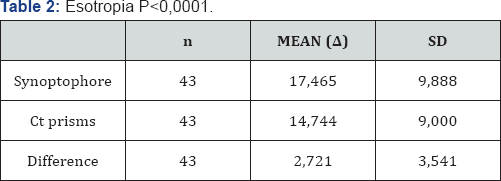JUNIPER
PUBLISHERS- JOJ Ophthalmology
Abstract
Objective: Based on the measurement of
strabismus angle with prisms at far vision, which is the most widely
used method, we compare it with the measurement performed with
synoptophore. We evaluate which factors influence the measurement with
synoptophore and with Cover Test with prisms at far vision.
Method: In a sample of 64 patients with a mean
age of 27.6 years, we consider two common clinical methods of measuring
the angle of ocular deviation: synoptophore and cover test with prisms.
Given the differences, we find between the measurement of the angle of
ocular deviation and what factors may influence the variability with
both methods.
Results: Comparing the measured deviation
angle in 64 patients with both methods at far vision, we found a
statistically significant difference, with an average of 1,844 prism
dioptres. If we compare both methods in esotropia or exotropia, in the
43 patients with esotropia found a statistically significant difference
(mean difference 2.721Dp). On the other hand, in the 21 patients with
exotropia there was no a statistically significant difference (mean
difference 0.048Dp.). Considering gender, 35 men of the sample, we find
statistically significant differences (mean difference 2.171Dp), and
women, 29 patients of the sample, we also found statistically
significant differences (mean difference 1.448Dp).
Conclusion: In esotropia we find that there
are statistically significant differences in cover test with prisms at
far vision. On the other hand, in exotropia we don’t find statistically
significant differences. In both the groups of patients with previous
strabismus surgery and non-surgery there are no statistically
significant differences. The fact that we find a greater deflection
angle with the synoptophore at convergent strabismus confirms the
ability of dissociation.
Keywords: Synoptophore; Cover test; Dissociate prism dioptre; Strabismus; Exotropia; EsotropiaIntroduction
The stereoscope invented by Charles Wheatstone in
1830 used for oculomotoras and sensory evaluation. Its main use is to
assess and treat strabismus, also used in vision therapy for the
treatment of amblyopia [1].
It simulates far vision conditions and presents separate images for
each eye. It studies oculomotoras and sensory capabilities mainly in
strabismus patients [2].
Although the measure of the deviation angle is usually performed with
prism bar or loose prisms, it is worth considering the synoptophore,
given its characteristics.
Compared with measurement with cover test (CT) and prisms, in synoptophore we obtain:
- Ahigher value of deviation as it is more dissociating.
- More simplicity and comfort in the measurement of the 9 positions of gaze thanks to its mechanical structure.
- The values are more reproducible, making it easier for monitoring the case.
- More accurate values in high-angle strabismus, since in these cases the measure is not performed in leaps.
- More objective measurement
Materials and Methods
In a sample of 64 patients, with a mean age of 27.6
years, we consider two common clinical methods of measuring the angle of
ocular deviation: synoptophore and Cover Test with prisms at far
vision. We study which differences we find between both methods and what
factors may influence the variability of the results. We studied the
influence of factors such as the direction of the horizontal deviation
(esotropia/ exotropia), if they had vertical deviation or some sort of
alphabetical syndrome, if they had undergone strabismus surgery
previously and finally the patient’s gender.
Results
Comparing the measurement of the deviation angle in
64 patients with synoptophore and cover test with prisms at far vision
we find:
Comparison in factors (Table 1):

Type of deviation

History of strabismus surgery

With previous surgery

Without previous surgery

Gender

We also assessed whether other factors such as
vertical deviations or alphabetic syndromes could influence the
comparison. Given the low percentage of patients who showed vertical
strabismus or alphabetical syndrome, comparative under these factors was
dismissed [3-8].
Discussion
Despite significant statistical differences in
convergent strabismus, in regular motor examination we always include
the measurement with synoptophore as well as the measurement with prism
at far vision.
We consider that the greater accommodative capability
that convergent strabismus present, both at far and near vision, allows
the synoptophore, as being more dissociating, to find greater deviation
angles. We believe that although with synoptophore there is a risk of
causing greater dissociation in some type of strabismus, for us its use
for justified the measure, because it is more accurate, objective and
reliable. Anyway we still complete the study with the measurement with
prisms. In our protocol for measuring ocular alignment we consider the
measurement with synoptophore, objectively, a complementary study to
consider.
Conclusion
In esotropia we found that there was statistically
significant differences respect to the measurement at distance with
prisms at far vision. In exotropia we didn’t find statistically
significant differences. Both in patients with previous strabismus
surgery and non-surgery there are statistically significant differences.
The fact that we find a greater deflection angle with the synoptophore
at convergent strabismus confirms the ability of dissociation that we
initially suspected occurs with Synoptophore [9-12].
For more articles in JOJ Ophthalmology (JOJO) please click on: https://juniperpublishers.com/jojo/index.php





No comments:
Post a Comment